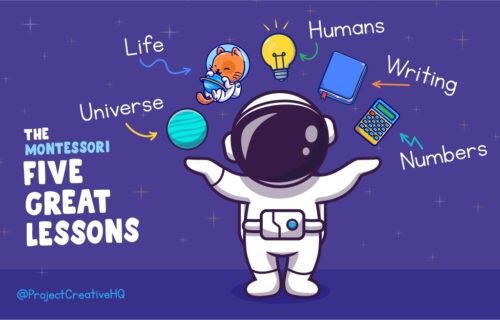The 5 Montessori Great Lessons That Ignite Curiosity
Discover the intriguing Montessori great lessons from the perspective of an experienced Montessori elementary teacher. Through years of leading and observing these lessons, I’ve seen their remarkable ability to captivate young learners in the second plane of development and spark a lasting curiosity for learning.
This blog unravels how stories make learning fun and exciting for kids, so keep reading to discover the magic they bring to elementary education!
The 5 Montessori Great Lessons
The Montessori great lessons, a set of five important stories, serve as a cornerstone in the Montessori curriculum, offering an immersive introduction to different subjects and concepts.
In lower elementary, grades 1 through 3, students explore the five great lessons, revisiting them each year. Unlike the 3 to 6 year old casa environment, where concepts start small and expand, in elementary, they take a look at big ideas, like the universe’s beginning, before seeing how smaller concepts fit in.
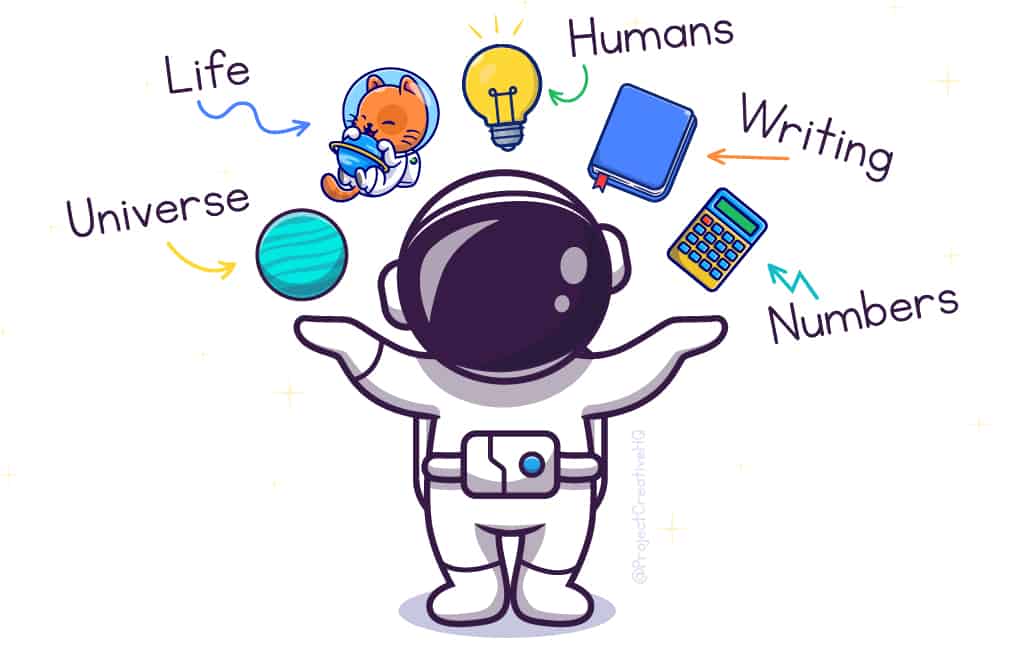
The five Montessori great lessons give an overview before diving into specific studies. These lessons include:
🪐 1st Montessori Great Lesson – The Coming of the Universe
🌱 2nd Montessori Great Lesson – The Coming of Life
🕺3rd Montessori Great Lesson – The Coming of Humans
📝 4th Montessori Great Lesson – The Story of Writing
🔢 5th Montessori Great Lesson – The Story of Numbers
Keep reading for engaging snippets from lesson scripts and discover the enchanting storytelling that fuels Montessori’s five great lessons.
1. The First Great Lesson: The Coming of the Universe
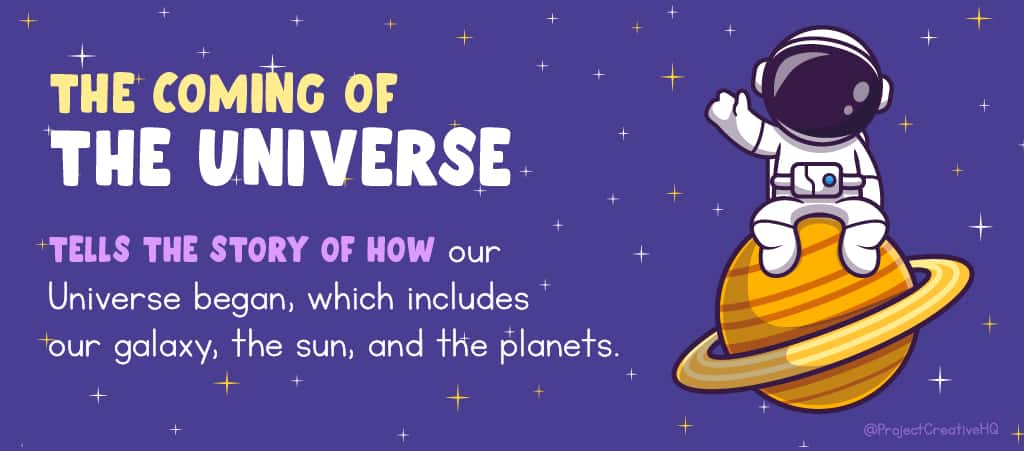
The first Great Lesson starts with a big bang and includes many engaging and alluring impressionistic charts as well as eye-catching experiments that help students understand the origins of the universe.
In this fascinating lesson, students are introduced to many advanced subjects in an easy-to-digest way. Details of how the earth was formed are described as student curiosity builds in the areas of Physics, Chemistry, Astronomy, and Geology.
The style of narrative in this presentation is similar to Egyptian mythology, Japanese Shinto tales, or Native American creation stories. The stories are accurate to current theories and accessible to the student’s imagination.
Let me give you a little peek at my script for the first Great Lesson. It’s a long story!
A Glimpse at the Script for the 1st Montessori Great Lesson
‘What did you see when you were outside today? Trees, the sun, clouds, people. What do you see at night? Stars, the moon, darkness.
Well, in the beginning, there was nothing.
No people, no trees, cities did not exist, animals did not exist, and even the Earth itself did not exist. There was nothing. No stars, no mountains, no rivers, no oceans. Nothing.
There was however a great space that had no beginning and no end. There was only chaos.
And it was dark; so dark that the darkest night you have ever experienced would seem like brilliant sunshine. Not only that, but it was cold; so cold that ice would seem warm.
Who can imagine that immensity, that darkness, and coldness?
And then BANG! (cue an exciting balloon pop with confetti coming out!) Suddenly – in an instant of great energy – a giant explosion occurred and a force brought the whole universe into being.
It’s here where time began and particles appeared. The particles were so small that even the smallest specks of dust would seem massive next to them.
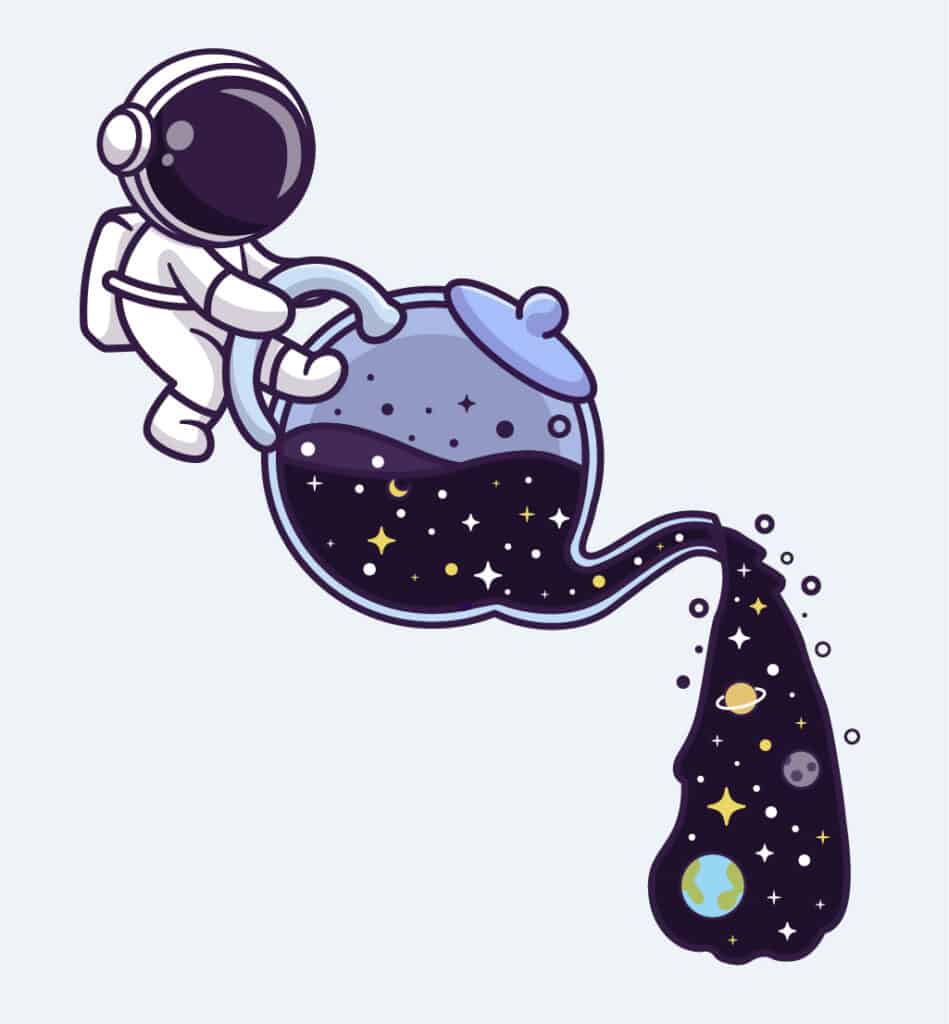
Oh, and there was now light – light greater than we can imagine (light a candle). A vast fiery cloud included all the stars that are in the sky.
The whole universe was in that cloud, and among the tiniest of stars was our own world. But they were not stars then; as yet, there was nothing except light and heat.
The heat was so intense that all the substances we know – iron, gold, earth, rocks, water – existed as gases.
All these substances, all the materials that the earth and the stars and you and I are composed, were fused together in one large, flaming intensity of light and heat – a heat which would make our sun today feel like a piece of ice.
Take a moment to picture that!
✨ NOTE: These script samples from the Montessori great lessons are condensed to highlight the beginning and end of each lesson.
For the full narratives and comprehensive resources, explore our listed references below. These tools will immerse you in the complete stories.
When the hot particles had finished their explosions, Earth cooled again and rains fell. It rained and rained and rained; the water filled in all the hollows. Lakes, rivers, ponds, and oceans were formed.
Finally, the clouds disappeared. The sun smiled down on this new Earth. Everything was beautiful and life was ready to begin. ‘
The first Montessori great lesson is always a hit with students. It’s flashy, includes awesome experiments and visuals, provides a lot of information but not too much, and really speaks to the elementary inquisitive mind.
I love watching the expressions on students’ faces as they take in the wonder of this first great lesson presentation.
They are absorbed by the creation of the world and interested in learning more about it. It’s worth the time needed to prepare and practice this lesson, I promise!
🕰 TEACHER TIP: It’s important to present the first of the 5 great lessons in Montessori as early in the school year as possible.
While some teachers like to give this lesson on the very first day of school, others prefer to build the classroom community for a week or so before getting into the first great lesson.
Whatever you choose, make sure it is within the first two weeks. You want to WOW them early on!
2. The Second Great Lesson: The Coming of Life
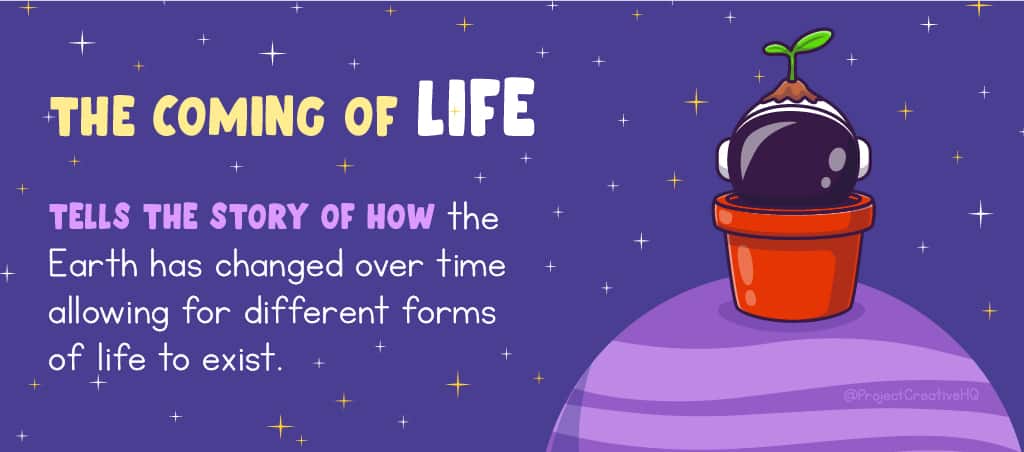
The second Montessori great lesson continues where the first one left off, exploring the Earth’s transformation across time, laying the foundation for life as we know it.
Students are introduced to different eras in time, how lifeforms have evolved, and how some have become extinct.
Dinosaurs, animals, plants, and microorganisms are outlined and explored. Students see how different life forms came to be on Earth, beginning with the most simple microscopic life forms in the ocean all the way to the appearance of early humans.
⏳ TEACHER TIP: Space out the great lesson presentations!
Space out your presentations of the Montessori 5 great lessons to allow students to delve into each one.
Rushing through these impactful lessons might overwhelm young learners.
Students are able to understand complicated scientific theories through the use of materials such as the Long Black Strip, the Clock of Eras, and the Timeline of Life.
Teachers tell an impressionistic story that spans the eras included in the material. These teaching resources provide eye-catching images and lots of information that allow students to really connect with the story of life.
This lively narrative incorporates cross-curricular learning and covers many classroom subjects. Students will see how Language, Math, Science, Language, Geography, History, as well as Art are all related to the coming of life.
A Glimpse at the Script for the 2nd Montessori Great Lesson
‘Remember the story of the universe coming to be? All the chaos, the heat, and then the cold, the darkness, and then the light?
Well, today we’re going to continue where that story left off. This story includes all of the plants and all sorts of animals that have inhabited this planet.
Earth was a beautiful little pearl lit up by the sun. Just a drop of heat and light, full of confusion and commotion.
In all of that, each particle was given a set of laws. And they followed those laws closely. As a result, the earth cooled and settled down.
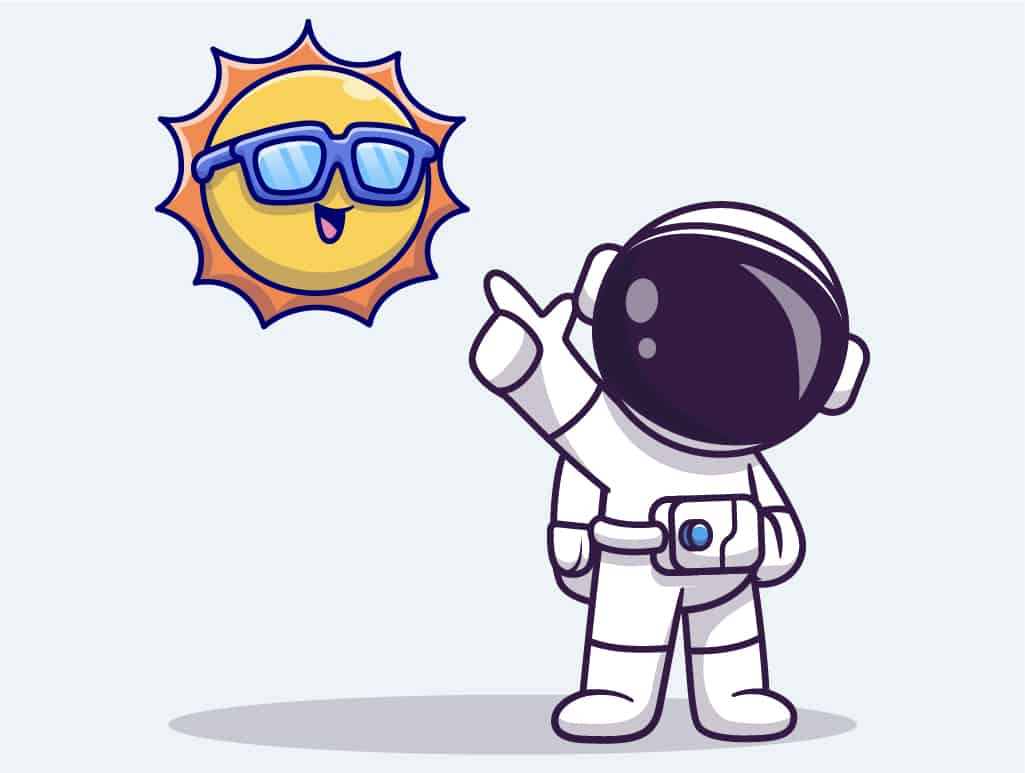
The Earth had cooled enough for rain to fill all the hollows but volcanoes still burst through the crust with their molten lava.
Gigantic electrical storms raced back and forth across Earth’s surface. Lightning passed through the seas and made a simple food, but there was nothing living in the seas to eat this broth.
And then something happened – 500 million years had passed – and a most amazing something happened in those waters! It was so tiny that it could hardly be seen.
These tiny particles had what no others had ever had before: the ability to make more of themselves.
And so these tiny organisms, which are still alive today, were the beginning of life on Earth!
…
On the timeline, you’ll notice that it was only 4 million years ago that a new primate walked on land on two legs. But that’s a story for another day!’
The second great lesson is an eye-opening one for elementary students. As they continue to see just how little time we humans have been on Earth, the development of an appreciation for all forms of life grows within them.
I always enjoy the questions that come with this lesson as well as the observations students make on the timeline.
Listening to students proudly pronounce (oftentimes incorrectly!) advanced words such as “prokaryotes” and “Cretaceous Period” really warms my teacher heart!
3. The Third Great Lesson: The Coming of Human Beings
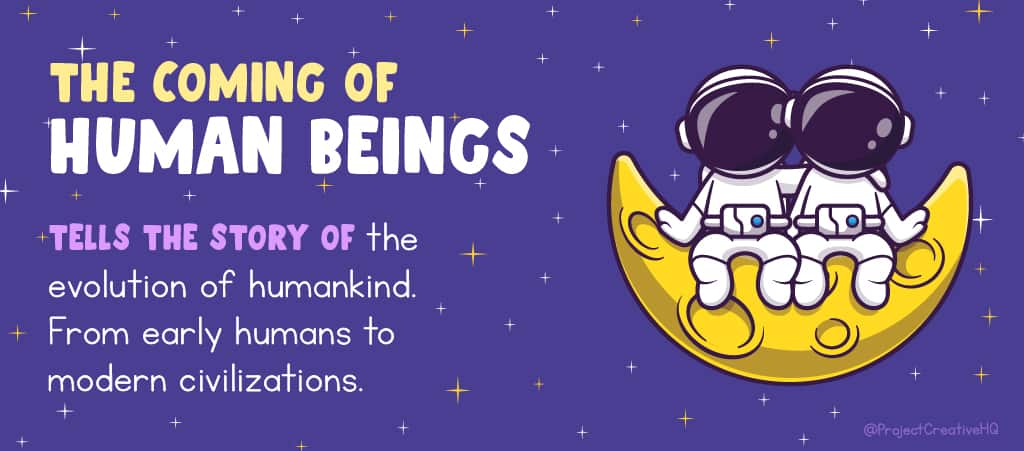
The third great lesson continues where the second great lesson leaves off, with the appearance of humans.
This story outlines the traits we have in common with other animals and the vital differences that enabled our species to survive and thrive on this planet.
Students learn about early humans, modern humans, civilizations, and the fundamental needs of humankind.
It tells the story of human survival and adaptation, how early civilizations arose, and how we met our needs in the past as well as in modern times.
The human use of the hand and its connection to the brain is discussed at great length. Students follow how humans evolved from living in caves and building fire to creating tools and machines that make our everyday life easier.
This presentation provides multidisciplinary curricular connectivity. Students learn how subjects such as History, Math, and Geography come together to tell the story of humans.
A Glimpse at the Script for the 3rd Montessori Great Lesson
‘Who remembers what the last mammal was on the Time Line of Life?
Human beings appeared on the earth but only after many other living creatures had come before them. They could only come when the earth was ready for them.
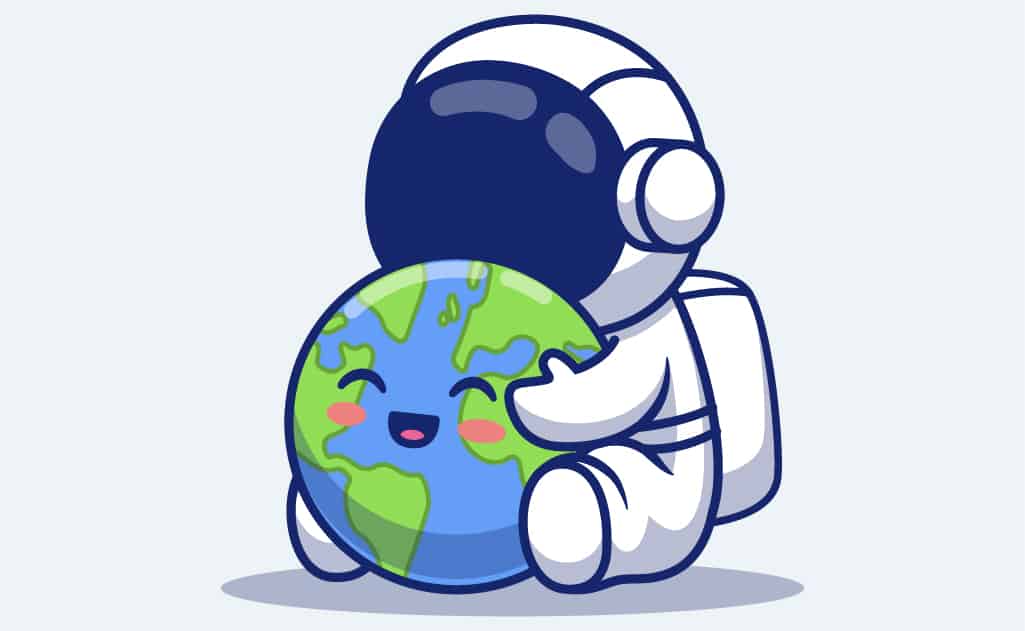
There was food for them to find, thick areas of grass and soil for them to walk on, and under the ground were vast stores of minerals that they would one day learn to use.
To be honest, the first human beings were not particularly suited for any specific area of the earth. They were not born knowing what to eat, or how to protect themselves.
Human beings were similar to other animals in some ways. They were mammals, which meant that they had hair, gave birth to live babies, and nursed them with milk afterward.
But they were also very different from other animals in some important ways. And it was because of these differences that the first people survived in the world that they found themselves in.
The first human beings walked on two feet. This freed their hands so that they could work with them. When humans discovered how to use tools with their hands it changed life forever.
They could make clothing when the weather turned colder during the Ice Age. They could make blankets to lay on, cut down trees to make houses, and they could even cover these houses with animal skins to keep the warmth in.
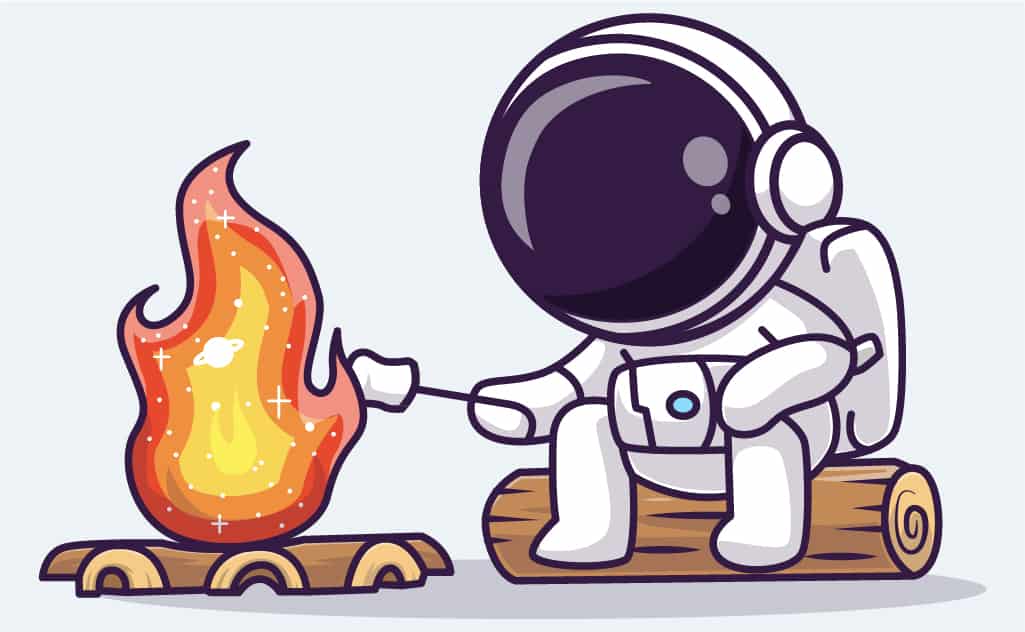
No other creature can do the things that humans can do with their hands.
What animal can sew clothes, drive a car safely, or draw a colourful picture? Only human beings thanks to their wonderful hands!
Another important gift that the first human beings had was a larger, more complex brain. With this brain, human beings could think about things. A force to be reckoned with!
You know what, human beings had one other gift. This was the most precious gift of all, and it is what truly made them human beings. They were able to love.
…
As humans evolved, they wanted to share their visions and keep track of what they did during the day, but that’s a whole other story.’
This story gives students a better idea of the very short span of time in which humans have lived on Earth.
They also see how the human hand and brain have worked in harmony over the years to advance civilizations.
My students always come up with the most peculiar and quite deep questions during and after the third Montessori great lesson presentation, such as “How long can humans survive without food?”, “Why are some humans sad?”, and my personal favourite, “What is our purpose here on Earth?”.
These questions deserve to be addressed as they provide platforms to jump into some serious learning.
I love watching as they follow their interest and independently find answers to their questions, with teacher guidance of course. They are taking ownership of their learning, building their knowledge base, and developing a love of learning.
4. The Fourth Great Lesson: The Story of Writing
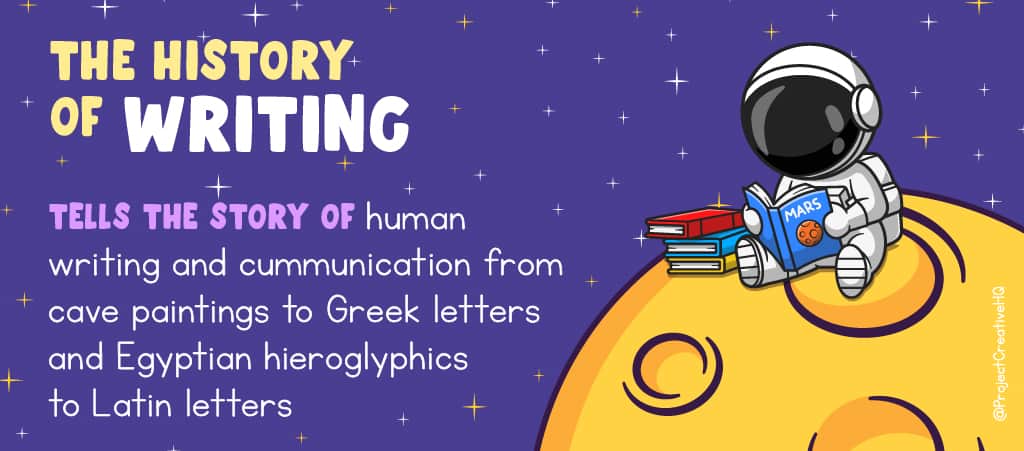
This Montessori great lesson is all about how the mind wants to share – or communicate – its ideas with others. It highlights how the use of language, pictures, and symbols for communication has been important to humans from the beginning of time.
The fourth great lesson draws parallels between cave paintings, Egyptian hieroglyphics, and the earliest forms of written communication, resembling original rebus puzzles. It encourages children to refine their reading, writing, and language abilities.
With no timeline to occupy the eye, students take in the story while referencing books and live artifacts to enhance their understanding and interest.
A connection between Language, History, Geography, Geometry, and Art is made as students see how these subjects have come together to construct the written word over the ages.
A Glimpse at the Script for the 4th Montessori Great Lesson
‘We know that the first human ancestors appeared on Earth over 4 million years. But did you know that the modern form of humans only evolved about 200,000 years ago?
At this point, they had learned to control fire, make complex tools, and survive variable climates. And they also learned how to put language into written form.
Because they wanted to share what they had seen and experienced, early humans drew on the walls of caves. We can learn a lot about what was important to these humans by studying their drawings.

…
Today the written word can travel from one part of the world to another in seconds. Computers and satellites have made that possible.
I bet one day communicating using good old-fashioned paper and pencil may be seen as how we now regard cave drawings, archaic!’
Students can take their learning in many different directions after this lesson.
I’ve observed students engage in writing messages using hieroglyphics, researching different alphabets, and even making their own paper to write on. I’ve even had a group of students create their own alphabet using emojis. Brilliant!
The fourth great lesson is also a good time to introduce unique vocabulary development activities such as rebus puzzles, roll a story, and scavenger hunts. Student interest is already elevated, so it’s a great time to add fun language learning games into the mix.
It’s also an excellent way to introduce and begin the elementary study of the 8 parts of speech where they will learn how words function.
💡 Uncover a world of literary wonders tailored for older elementary students with our curated collection of 31 picture books for 5th graders.
These books will ignite their imaginations and spark a love for reading within them.
Then read our blog Classroom Vocabulary Activities: 11 Exciting Post-Picture Book Reading Ideas to keep the learning going.
I really like this great lesson on writing because it gives elementary students an appreciation for words and how they are transcribed.
In a day and age where the written word is becoming more and more obsolete, I’m always eager to share this lesson with students. Long live the written word!
💡 TEACHER TIP: Pique their interest with writing-related artifacts!
Have any intriguing artifacts lying around your home? A quill? A typewriter? I’d be really impressed if you had a clay tablet or a scroll of papyrus!
When students can manipulate live samples with their hands they are more likely to connect to the content and be interested in learning more.
5. The Fifth Great Lesson: The Story of Numbers

The fifth great lesson introduces students to various forms and methods of counting and record-keeping from the beginning of time. Students learn about the history of numbers.
This presentation is the basis for learning math and is designed to get students interested and excited by numbers.
Before learning how to use the racks and tubes material for long division, the checkerboard for multiplication, or the algebraic peg board for factoring, Montessori elementary students learn about the origin of numbers.
Through this fifth story, students come to realize that math is the common language of the world as well as an expression of the refinement of the human mind. Regardless of how primitive or complicated a culture is, a system of counting and tracking is required.
Students come to see that math is everywhere, even intertwined with other subject areas such as History and Language. An appreciation for numbers is developed here.
A Glimpse at the Script for the 5th Montessori Great Lesson
‘Counting and keeping track of numbers is important. How many people are in your family? What time does the sun go down? How long does it take you to walk to the park?
All human beings need a counting system. From the beginning of time, even early humans were keeping track of things and time.
We cannot tell what the first numbers were because no one wrote them down. These numbers were only used when people spoke.
Humans needed some way to record how many things they had and a way to track how long it took to do things. Some used their fingers, others used pebbles, shells, knots on a string, and some even used notches made in a piece of wood.
It is said that the earliest civilizations used “one”, “two”, and “more than two” as their numeric system. Pretty straightforward, right!?!?

Later the Malayan people counted with pebbles. They kept a record of what they had by using a pebble to represent each one.
If a farmer wanted to know how many pigs they had, they might put a pebble down when they saw one and keep going until they had counted them all.
They would count how many pebbles they had placed and know how many pigs there were altogether. Simple math in action.
…
All that has come before brings us to where we are today. Nowadays the most common number system used is called base-ten, or the decimal system. We can use 10 digits, zero through nine, to write any number.
Definitely a much more simple way of tracking numbers compared to counting pebbles!
I also like to expand on this last Montessori great lesson with some fun math activities for elementary students or math dice games. When learning is less like learning it is more likely that concepts will stick. Imagine that!
🔢 Expand their math skills with a math card game!
Elevate elementary math skills with this exciting math card game and get kids playing and learning!
This presentation captures the interest of elementary students because numbers are pretty spectacular.
Numbers engage a child’s sense of curiosity and wonder. The bigger the better and the more complex to pronounce. Fun!
While perhaps not the most “fantastical” of the 5 great lessons Montessori students witness, it is the presentation I connect with the most.
I love how it leaves students wanting to know more about numbers. As they take on new information, new interests form, and they are pulled to do their own research.
I had one second-grade student become absorbed with time zones.
She studied the ins and out of the lines of latitude and longitude, researched the time zones of every country (Yay pin maps!), and marked desired vacation spots all over North America on a map according to their time zone.
This is cosmic education, my friends. The story of numbers serves as a way to see how everything is connected. Like integrating their Geography knowledge with Math skills in the study of time zones.
We call it learning in disguise or stealth learning, but I’m going to be real here, we can also call it fun!
🔢 Enhance your classroom with our Montessori Bead Bar Poster! Transform your learning space with this visually engaging math material turned stunning wall decor. Explore its charm now!
The Montessori Great Lessons Excite Young Minds
Five great lessons in Montessori are a unique aspect of the elementary curriculum.
When these impressionistic stories – grandiose and intriguing in their delivery – are presented to a lower elementary class they awaken and excite the child’s mind.
There’s nothing better than observing the pensive facial expressions of students as they experience the wonder of the Montessori great lessons.
Their eyes widen, their heads tilt, their jaws drop open slightly, and their eyebrows move up and down. They are in awe of what is being presented to them.
I’ve observed students so captivated by the information presented that they take it upon themselves to continue studying the topic presented in a great lesson.
They are inspired to learn more. They want to learn more. A love of learning has been sparked.
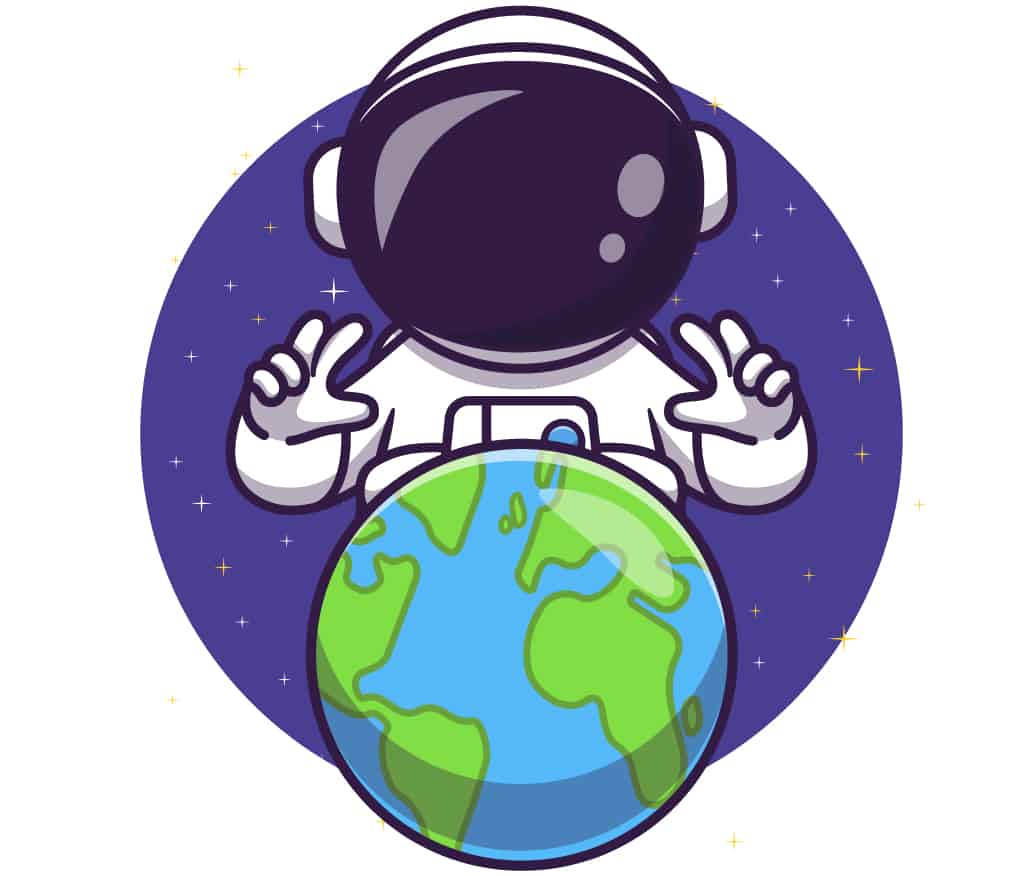
Since these lessons are presented at the lower elementary level every year, children have the opportunity to revisit and expand on their learning year after year.
They build on their interests and develop new ones, too. These are exciting presentations for all students!
🙌🏼 Teacher Tip: Seek out experienced helping hands!
When presenting the 5 great lessons in Montessori to lower elementary students, consider enlisting help from experienced upper elementary students. This mentorship not only reinforces older students’ knowledge but also fosters a sense of guidance for younger learners, creating an enriching learning environment.
Each great lesson serves to initiate student exploration and discovery. The second plane child – our curious elementary student – is becoming aware of the world around them and they want to know their place in it.
The 5 Montessori great lessons give learners a look at the bigger picture – the world as a whole – using expressive stories and visuals, before delving into deeper more focused exploration and study of topics.
Through the 5 Montessori great stories, elementary students gain an appreciation and respect for those who came before them and develop an excitement for what is to come in the future.
What is Montessori?
Montessori is an educational philosophy that is based on self-directed activity, hands-on learning, and collaboration with peers.
With the use of specialized materials, a beautifully prepared classroom environment, and engaging lesson presentations, students experience learning with their own hands and at their own pace.
Starting with the infant and toddler program, Montessori classrooms exist all the way up to the high school years.
At every level, important elements such as mixed-age classrooms, student freedom in activity selection, and long blocks of uninterrupted work time exist to support and enhance student success.
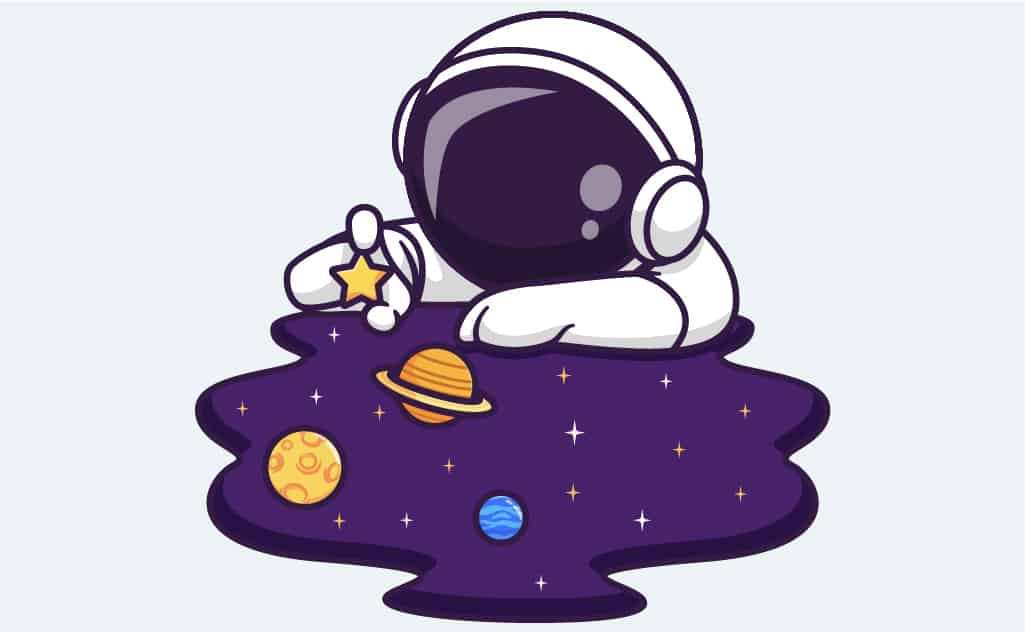
Dr. Maria Montessori observed that children take control of their own education when they are able to learn at their own pace and with their own interests guiding them. For me, this quote really embodies the Montessori mindset.
“We must help the child to act for himself, will for himself, think for himself; this is the art of those who aspire to serve the spirit.”
Dr. Maria Montessori
In Montessori classrooms, students make choices in their learning, while the classroom and the teacher offer age-appropriate activities to guide the process. The five Montessori great lessons are an important part of this process and lead to independent discovery.
Want to learn more about Montessori education? Check out our blog Montessori vs Traditional School, it’s bursting with information!
Exploring the Essence of the Montessori Great Lessons
Have you ever listened to someone tell a story, a really good one with lots of details and maybe even some impressive images? A story that leaves you with the urge to do your own research and learn more about the topic? One that sticks with you over time?
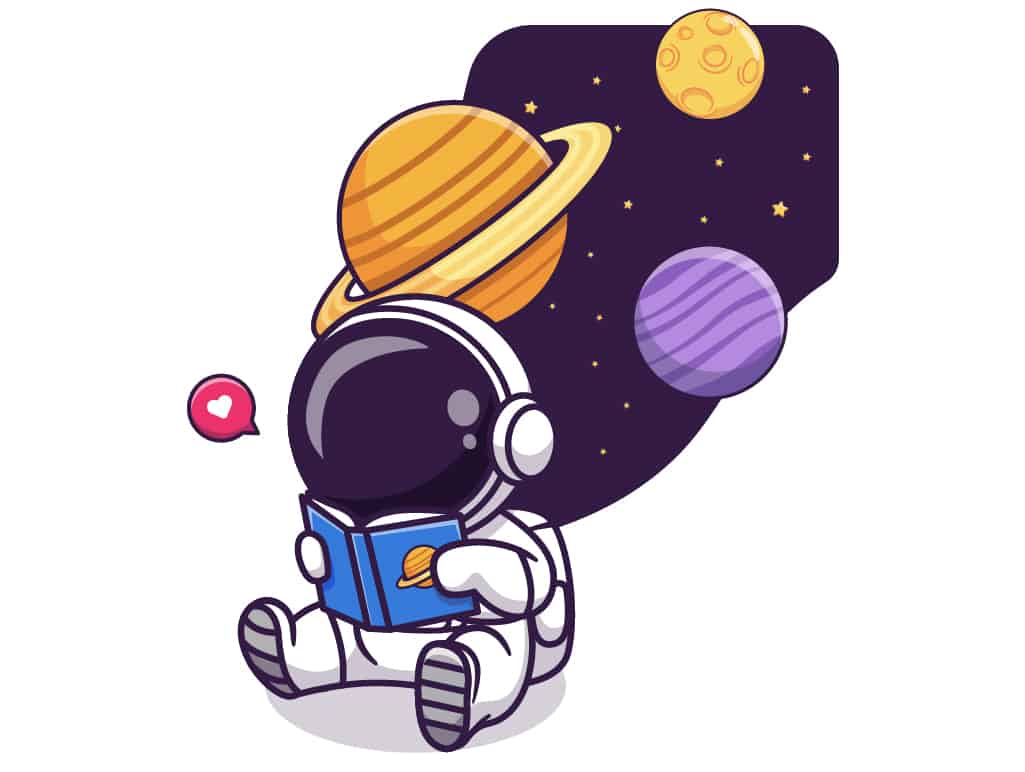
That’s what the Montessori great lessons are meant to do.
They are designed to have students hang on to the words of each impressionistic story and motivate them to explore the subject further. They are encouraged, actually guided, to follow their interests and learn more about all sorts of topics.
I think these lessons are very important and for many reasons. They boost listening skills, foster imagination, sharpen students’ memory, as well as promote active participation and a love of learning just to name a few.
But what stands out the most to me is the interconnectedness that runs through each of Montessori’s 5 great lessons.
These powerful stories are important because they integrate a variety of school subjects.
From Astronomy to Biology, and from Language to Mathematics these educational topics come together to tell a terrific tale. Students see firsthand how all things in life are interconnected.
Taught in chronological order in which they occur in nature, students experience the development of the universe, life, and humanity all while figuring out their place in this humungous world.
They begin to see and understand how all things are connected in the universe around them.
Students remember these presentations and look forward to seeing them again. Each time they experience a Great Lesson they are at a different age and therefore approach it with a different perspective and a new wave of wonder.
Without really knowing it, students are learning to think independently and building their knowledge of how life came to be.
The 5 Montessori Great Lessons: Best Resources
Not sure where to start in terms of what resources to use for your Montessori Great Lessons?
That’s what we’re here for! We’ve done the research for you and compiled a list of the best resources for these spectacular lessons.

So before you start planning and preparing, make sure that your Montessori Great Lessons are really great with the use of some of these spectacular resources.
General Montessori Great Lessons Resources
These resources will help you get your Great Lesson journey off the ground.
- Miss Barbara’s Great Lessons page is a great place to start. You’ll find outlines of all five stories, follow-up activities, and other resources to maximize the greatness of your lessons. Miss Barbara knows Montessori!
- Get acquainted with cosmic education and the interconnectedness of everything with Children of the Universe: Cosmic Education in the Montessori Elementary Classroom by Michael Duffy. Each chapter outlines a Great Story, including the Story of the Universe, Solar System, Earth, Life, Humans, and Civilizations. You’ll find lots of great ideas and resources and it provides helpful context as well.
- From the Big Bang all the way through to the digital age, DK’s Timelines of Everything is a beautiful visual encyclopedia for elementary students illustrating a whole lot of what has happened in history.
Resources for Lesson #1 – The Coming of the Universe
Provide your learners with books to continue their research after the first Montessori great lesson and watch as they realize just how small we are over here on planet Earth.
- A great way to introduce students to the science of space and the Big Bang, Earth Story is written simply and elegantly with each page containing captivating painted illustrations. It begins with the big bang and ends with “…the first living thing: a clever little squiggle. …But that’s another story.” Fun!
- Students will learn where it all started in Born with a Bang, a scientifically accurate book telling the story of the universe up until the formation of young Earth.
- There’s something magical about wordless picture books. Looking Down is full of magic and teachable moments! It’s sort of like a low-tech version of Google maps. Pictures start with a view of Earth from space and zoom in as the pages are flipped all the way down to spots on a ladybug. Very effective for showing the Earth from different perspectives!
🌱 Resources for Lesson #2 – The Coming of Life
Pair your timeline of life with some or all of these eye-catching books capable of bringing learning to life!
- The scientific information in From Lava to Life is accurate and the level of detail is just right for elementary learners. Students will be intrigued by the vivid graphics while they absorb the basics of the evolutionary history of life up to the extinction of the dinosaurs.
- Fossils Tell of Long Ago is an age-appropriate, colourfully illustrated nonfiction picture book that describes how fossils are made. This book even includes a section on how to make “fossils” for others to discover. Neat!
- The Story of Life Evolution is an informative and beautiful book that aligns with the timeline of life lessons. Great to introduce and illustrate the evolution process.
Resources for Lesson #3 – The Coming of Humans
Using books to enhance students’ understanding and interest in the timeline of humans is key to broadening their knowledge base.
- Mammals Who Morph is the third book of a series and is a scientifically accurate telling of the story of mammals and humans. This entire series is a must for early elementary children. It is beautifully illustrated and explains scientific terms in a way that can be easily understood.
- The Stick and Stone Age is a cartoon history of the Earth. This book is educational and funny at the same time.
- Beautifully illustrated and wonderfully written, A City Through Time is the type of book that students can spend hours studying the pictures and, without even realizing it, absorbing interesting and useful information.
Resources for Lesson #4 – The Story of Writing
No timeline for this lesson, so now what? Book, books, books! I like to support the story of the development of the written word with a few fascinating books.
Here are a few I believe your students will enjoy.
- Ox, House, Stick: The History of Our Alphabet traces the history of the letters we are so familiar with yet know little about. This book is written with the elementary child in mind but is great for adults too. It’s informative, entertaining, and easy on the eyes.
- From how writing began all the way to the age of the Internet, The Story of Writing is a fascinating account of the development of writing and how it has changed people’s lives. With more than 100 photos of artifacts and documents from the collection of the British Museum, The Story of Writing is a great resource to reference during this Great Lesson.
- The Word Collector is a picture book promoting the value of words. As a Montessori teacher, I see this as a book that encourages the growth of vocabulary from thought, to spoken word, to written, permanent word. Show students the transformative and profound power of words with this fun book.
- Build your students’ vocabulary with Carl the Cantankerous Cat and show them that using “big words” can be fun! This picture book introduces readers to 70+ advanced vocabulary words. Get students excited about learning new words with Carl!
- And here’s one for the grown-ups! The Story of Writing is a great reference for teachers and any adult looking to know more about the evolution of writing. This book takes a captivating and informative look at the history of communication within the human species.
Resources for Lesson #5 – The Story of Numbers
Once again, no official timeline exists for this last Montessori Great Lesson, so the narrative needs to be supplemented with informative and interesting books.
Books that discuss the simplest counting systems of early civilizations or explore how different number systems have been developed throughout history in different parts of the world are essential here. These books are great for this fifth Montessori Great Lesson.
- The Story of Money outlines the history of money from bartering to the modern monetary system. I think it’s a great teaching tool on not only the history of money but the concept of money, as well as the value of money. Explore our range of kids’ books about money for a broader understanding!
- On a scale of I to X, Fun With Roman Numerals is a XIII! This book teaches Roman numerals in a simplistic way using real-life examples to support learning. Featuring easy explanations, a helpful chart at the back of the book for review, and fun pictures, this book is sure to get students excited by numbers.
- In chronological order from pre-history to the present day, A Quick History of Math is the story of maths itself. This book makes math fun! Great graphics and clear wording make this perfect for elementary learners to understand. Many laughs will be had while flipping through this funny and educational book.
- What’s the Point of Math guides readers to see that math is an essential part of our everyday life, often in ways that are never thought of. An interesting, illustrated story on math outlining how it evolved and why we need it. Perfect addition to this Montessori Great Lesson.
- Counting on Katherine is an accurate and exciting picture book. The colourful, whole-page illustrations are fantastic and inviting. This story is a small slice of history with a huge impact. Katherine Johnson was a hero and an amazing mathematician. An inspirational story for young inquisitive minds.
Side note – Your avid readers may appreciate the book Hidden Figures, outlining Katherine Johnson’s story. It might also interest you to know that there is a Hidden Figures movie. But remember, the book is always better!
Complementing your Montessori great lessons with great books is a great way to engage learners and give them somewhere to go to further their knowledge.
We hope that these resources are helpful when you are gathering books to help support your lessons.
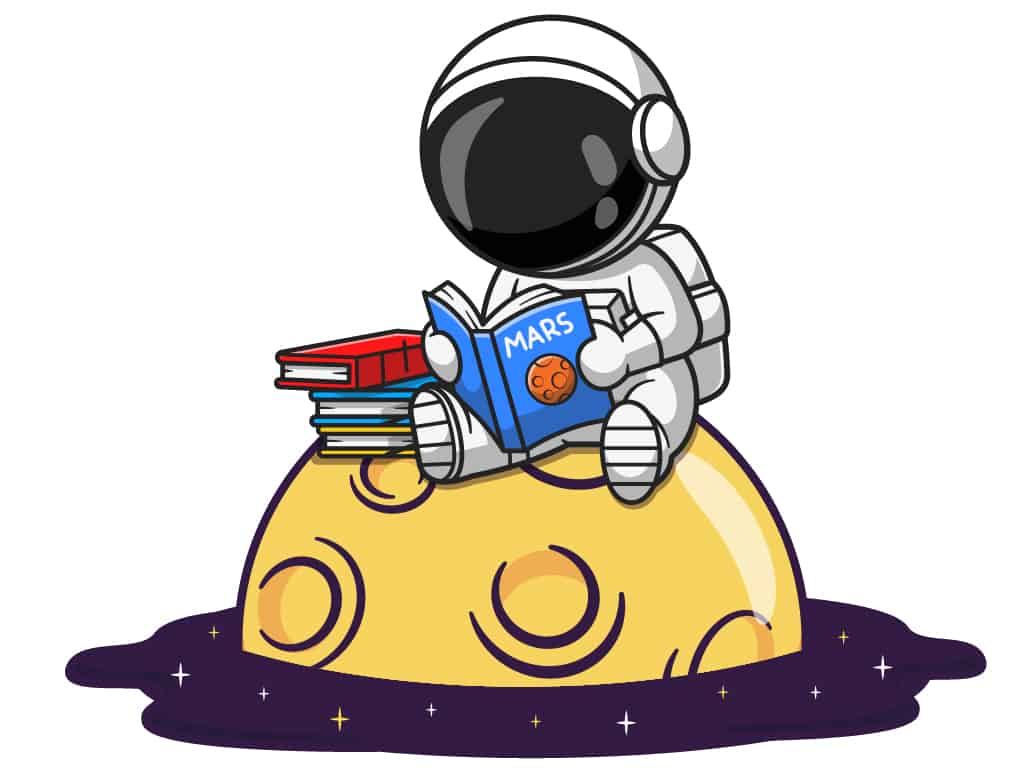
📚Looking for more elementary resources? We’ve got you covered!
Check these out:
31 Captivating Picture Books for 5th Graders with Expert Tips for Selection
11 Ways to Use Our Roll A Story Dice Game
13 Engaging Vocabulary Development Activities for Elementary Kids
The Wrap-Up: Montessori Great Lessons
The 5 Montessori great lessons are an important part of developing a love of learning in the elementary classroom as they speak to the inquisitive mind of the child in the second plane of development.
Used as a springboard for learning rather than the focus or endpoint, the Montessori great lessons allow students to explore advanced concepts in an easy-to-understand way.
Each story is meant to inspire curiosity and an interest in continuing their quest for information through independent research.
The great lessons contain an enormous amount of information about the origins of the world around us. When each story is shared, it leads to further study. Students get to explore further, learn more, and ask a whole lot of questions.
And that’s why the Montessori five great lessons are so important.
🧐 Keep your kids busy learning with these educational activities:
Rebus Puzzles for Kids: A Comprehensive Riddle-Solving Guide
31 Fun Summer Reading Activities Elementary Students Will Love
The Best Neighborhood Walk Scavenger Hunt & 13 Different Ways to Use It
8 Easy Rebus Puzzles with Answers
27 Educational YouTube Channels to Prevent Summer Learning Loss
How to Make a Scavenger Hunt for Kids in 9 Steps
15 Educational Games With Three Dice for Kids
21 Fun Math Games with Dice for Kids 8-12


